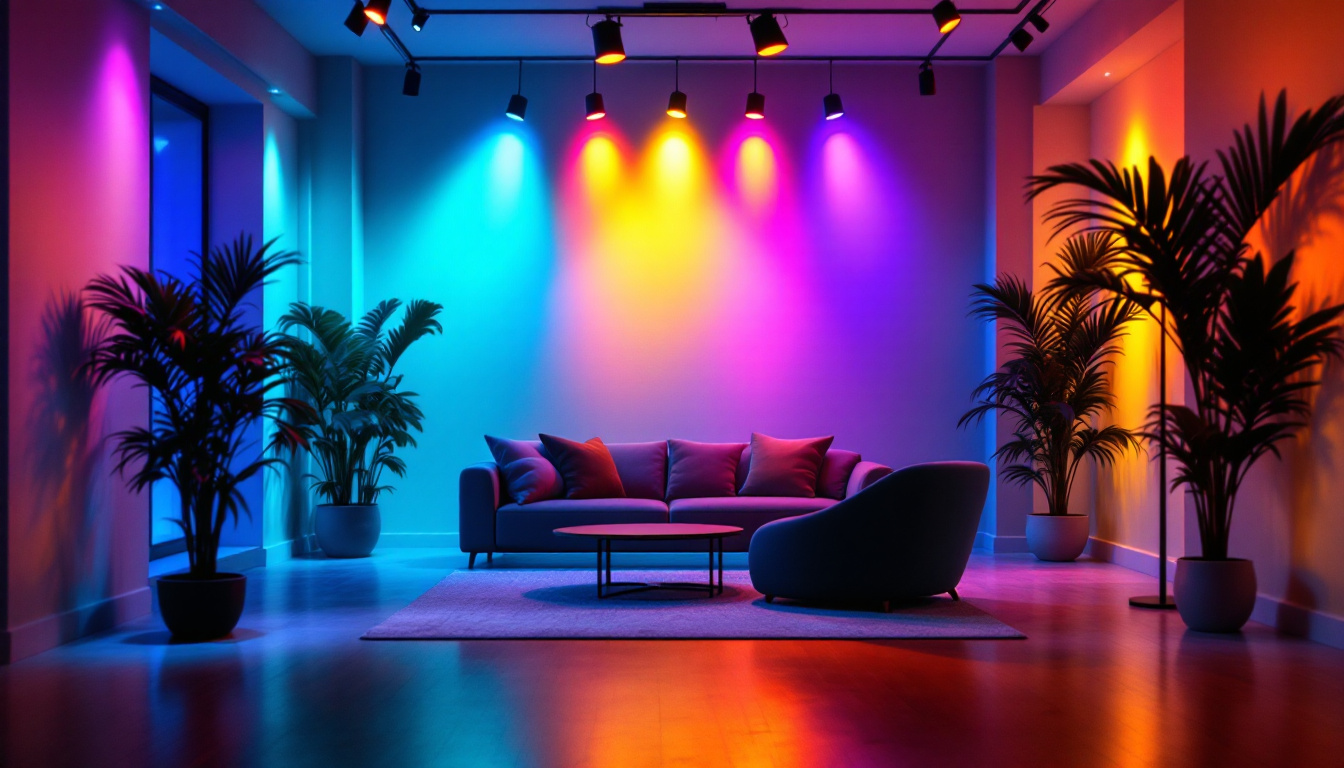
In the world of lighting design, RGB can lights have emerged as a versatile and dynamic solution for both residential and commercial spaces. However, their installation and integration into lighting projects can pose several challenges. For lighting contractors, understanding how to navigate these challenges is crucial to avoid costly mistakes. This article will explore the common pitfalls associated with RGB can lights and provide insights on how to ensure successful lighting projects.
RGB can lights are a type of recessed lighting that utilizes red, green, and blue LEDs to create a wide spectrum of colors. This flexibility allows for customizable lighting effects that can enhance the ambiance of any space. However, the technology behind RGB lights is complex, and proper knowledge is essential for effective implementation.
At the heart of RGB can lights is the ability to mix colors through additive color mixing. By adjusting the intensity of each color channel, a vast array of colors can be produced. Understanding how these colors interact is fundamental for contractors aiming to create specific moods or themes in a space.
Moreover, RGB can lights often come with various control options, including remote controls, wall switches, and smart home integration. Each control method has its own set of requirements and limitations, which contractors must consider during installation. For instance, smart home integration allows users to program lighting scenes that can change throughout the day, aligning with natural light patterns or specific activities. This feature not only enhances convenience but also promotes energy efficiency by allowing users to schedule lights to turn off when not needed.
RGB can lights are suitable for various applications, from residential settings to commercial venues. In homes, they can be used to create mood lighting in living rooms, bedrooms, or home theaters. In commercial spaces, they can enhance the atmosphere of restaurants, retail stores, and event venues.
Understanding the specific needs of each project is crucial. For instance, a restaurant may require softer hues to create an intimate dining experience, while a retail store might benefit from vibrant colors that attract customers. Tailoring the lighting to the environment can significantly influence the overall success of the project. Additionally, RGB can lights can be programmed for special events or seasonal decorations, allowing businesses to easily switch themes for holidays or promotional events. This versatility not only captivates customers but also fosters a memorable experience that encourages repeat visits.
Furthermore, RGB can lights can also be employed in outdoor settings, transforming patios, gardens, and walkways into enchanting spaces. By strategically placing these lights, homeowners can create an inviting atmosphere for outdoor gatherings or simply enjoy a serene evening under the stars. The ability to change colors can also enhance landscaping features, highlighting trees, shrubs, and architectural elements, making them stand out beautifully at night. As technology continues to evolve, the potential applications of RGB can lights are expanding, offering even more creative possibilities for both residential and commercial use.
Despite their advantages, RGB can lights can lead to several costly mistakes if not handled correctly. Awareness of these common pitfalls can help contractors avoid unnecessary expenses and ensure client satisfaction.
One of the most significant mistakes contractors make is failing to plan and design the lighting layout adequately. A well-thought-out plan should consider the purpose of the space, the desired mood, and the technical requirements of the RGB system.
Contractors should conduct thorough consultations with clients to understand their vision and expectations. Sketching out a lighting design that includes the placement of RGB can lights, control systems, and power sources can help avoid last-minute adjustments that may lead to increased costs. Additionally, utilizing design software can provide a visual representation of how the RGB lighting will interact with the space, allowing clients to visualize their ideas and make informed decisions. This step not only enhances communication but also fosters a collaborative environment where clients feel more invested in the project.
RGB can lights often come with various dimming and control options, yet many contractors overlook these features during installation. Properly integrating dimmers and control systems can enhance the versatility of the lighting, allowing clients to adjust the ambiance as needed.
Failure to consider these options can lead to a static lighting setup that does not meet the client’s needs. It is essential to discuss control preferences with clients early in the project and ensure that the chosen system is compatible with the RGB can lights being installed. Furthermore, educating clients about the different control methods available, such as smartphone apps or voice-activated systems, can enhance their experience and satisfaction. By providing clients with the tools to customize their lighting, contractors can create a more dynamic and engaging environment that adapts to various occasions and moods.
Another common oversight is the power requirements of RGB can lights. These fixtures often require specific voltage and wattage, and failing to account for this can lead to performance issues or even damage to the lights.
Contractors should verify the electrical specifications and ensure that the existing wiring can support the new fixtures. In some cases, additional circuits may be necessary to accommodate the power demands of RGB can lights, which can add to project costs if not planned for in advance. Moreover, understanding the load capacity of the circuit is crucial, as overloading can result in tripped breakers or even electrical fires. By conducting a thorough assessment of the electrical system and making necessary upgrades, contractors can ensure a safe and efficient installation that meets the demands of the RGB lighting setup, ultimately leading to a more reliable and longer-lasting solution for clients.
To avoid costly mistakes and ensure successful RGB lighting projects, contractors should adopt several best practices. These strategies can help streamline the installation process and enhance client satisfaction.
Before beginning any project, a comprehensive assessment of the space is essential. This includes evaluating the size, layout, and existing lighting conditions. Understanding how natural light interacts with the space can also inform the design and placement of RGB can lights.
Contractors should take measurements and consider factors such as ceiling height and surface colors, as these can significantly impact the effectiveness of the lighting. A well-assessed space will lead to a more tailored and effective lighting solution.
Effective communication with clients is paramount throughout the project. Engaging in discussions about their preferences, expectations, and any concerns they may have can help build trust and ensure alignment on the project goals.
Regular updates and check-ins during the installation process can also help address any issues that arise promptly. This proactive approach can prevent misunderstandings and foster a collaborative environment, ultimately leading to a more successful project outcome.
Investing in high-quality RGB can lights and associated components is crucial for long-term success. While it may be tempting to opt for cheaper alternatives, low-quality products can lead to performance issues, increased maintenance costs, and dissatisfied clients.
Contractors should research reputable manufacturers and select products that meet industry standards. Quality fixtures not only enhance the aesthetic appeal of the space but also ensure reliability and longevity, resulting in satisfied clients and repeat business.
As technology continues to evolve, integrating smart systems into RGB lighting projects has become increasingly popular. Smart technology offers enhanced control and convenience, allowing clients to customize their lighting experience effortlessly.
Smart RGB lighting systems enable clients to control their lights remotely through smartphones or voice-activated devices. This level of convenience can significantly enhance the user experience, allowing for easy adjustments to color and brightness based on mood or occasion.
Additionally, smart systems often come with pre-set lighting scenes that can be programmed for various activities, such as movie nights or dinner parties. This feature not only adds value to the installation but can also set a contractor apart in a competitive market.
While integrating smart technology can enhance RGB lighting projects, there are several considerations to keep in mind. Compatibility between the RGB can lights and the smart control system is essential. Contractors should ensure that the chosen products can communicate effectively to avoid any functionality issues.
Furthermore, educating clients on how to use the smart features and troubleshoot common problems can enhance their satisfaction and confidence in the system. Providing clear instructions and support can help clients maximize the benefits of their new lighting setup.
RGB can lights offer a wealth of possibilities for creating dynamic and engaging lighting solutions. However, the complexity of their installation and integration requires careful planning and execution. By understanding the common pitfalls and adopting best practices, lighting contractors can avoid costly mistakes and deliver exceptional results.
Through thorough assessments, open communication, quality product selection, and the integration of smart technology, contractors can enhance their projects and ensure client satisfaction. As the demand for innovative lighting solutions continues to grow, mastering the art of RGB can lights will undoubtedly position contractors for success in the ever-evolving lighting industry.
Ready to elevate your lighting projects with the dynamic capabilities of RGB can lights? Look no further than LumenWholesale for all your lighting needs. We provide contractors with high-quality, spec-grade lighting products at unbeatable wholesale prices, ensuring you get the best value for your investment. Our extensive selection is designed to meet the highest industry standards, so you can deliver reliable, high-performance lighting solutions to your clients. Plus, with free shipping on bulk orders, you can enjoy premium lighting without hidden fees or compromises. Don’t let costly mistakes derail your projects—choose LumenWholesale for the perfect blend of quality, affordability, and convenience. Wholesale Lighting at the Best Value is just a click away.

Discover the essential guide to lead light bulbs tailored for lighting contractors.

Discover innovative strategies to future-proof your outdoor lighting projects.

Explore the advantages and drawbacks of sourcing industrial lighting products in Sanford, Florida, tailored for lighting contractors.

Discover the ultimate guide to the GE Halogen FL25 Beam 38W 120V, tailored for lighting professionals.